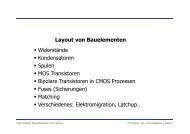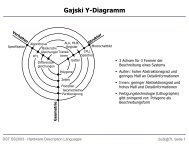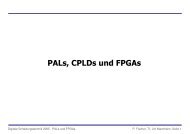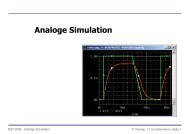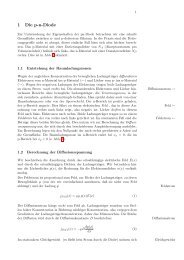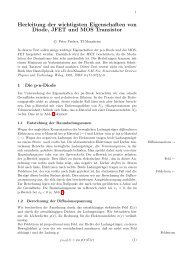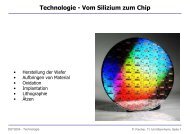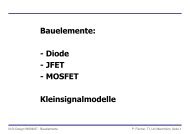VLSI Design: SKILL - Lehrstuhl für Schaltungstechnik und Simulation
VLSI Design: SKILL - Lehrstuhl für Schaltungstechnik und Simulation
VLSI Design: SKILL - Lehrstuhl für Schaltungstechnik und Simulation
Create successful ePaper yourself
Turn your PDF publications into a flip-book with our unique Google optimized e-Paper software.
<strong>VLSI</strong> <strong>Design</strong>:<br />
<strong>SKILL</strong><br />
Prof. Dr. P. Fischer<br />
<strong>Lehrstuhl</strong> für <strong>Schaltungstechnik</strong> <strong>und</strong> <strong>Simulation</strong><br />
Technische Informatik der Uni Heidelberg<br />
<strong>VLSI</strong> <strong>Design</strong> - Skill<br />
© P. Fischer, ZITI, Uni Heidelberg Page1
What is Skill and what can it do <br />
<strong>SKILL</strong> is the shell / control language of cadence<br />
It is used for<br />
• Configuration of the environment<br />
• Definition of library path<br />
• …<br />
• Configuration of tools<br />
• Definition of ShortCuts<br />
• Definitions of new commands / menu entries<br />
• …<br />
Skill allows, for instance, direct access to objects in an open<br />
view for<br />
• Scripted creation of shapes / labels / …<br />
• Automated creation of symbols<br />
• Extraction of pad positions, …<br />
<strong>VLSI</strong> <strong>Design</strong> - Skill<br />
© P. Fischer, ZITI, Uni Heidelberg Page2
How does <strong>SKILL</strong> look like<br />
<strong>SKILL</strong> – in its ‘natural’ form – is very similar to LISP (‘LISt<br />
Processing’)<br />
• Commands have the form( cmd arg1 arg2 ... )<br />
• Data is mostly stored as lists<br />
Operators are possible as well, i.e.<br />
•3 + 5 (equivalent to (plus 3 5))<br />
•x = 6<br />
A ‘C-like’ form is possible as well: cmd( args..)<br />
• Note that the ( must DIRECTLY follow cmd, i.e. with NO blank!<br />
<strong>SKILL</strong> is caseSENsitTive!<br />
Comments are started by // or enclosed in /*...*/ (as C)<br />
<strong>SKILL</strong> is – normally – interpreted<br />
• it can also be compiled (→ *.cxt) end encrypted<br />
<strong>VLSI</strong> <strong>Design</strong> - Skill<br />
© P. Fischer, ZITI, Uni Heidelberg Page3
Where to find Help & Documentation <br />
At http://en.wikipedia.org/wiki/Cadence_<strong>SKILL</strong><br />
On our Linux machines using a Web browser at<br />
/opt/eda/IC615/doc/...<br />
There you find for instance<br />
Path<br />
sklangref/sklangrefTOC.html<br />
sklanguser/sklanguserTOC.html<br />
skdevref/skdevrefTOC.html<br />
skdfrefTOC.html<br />
sklayoutref/sklayoutrefTOC.html<br />
Purpose<br />
Structure, Basic Commands<br />
Data structures<br />
Routines<br />
Data objects<br />
Layout specific stuff<br />
Best save some links in your browser!<br />
• If you use ssh, you can start for instance firefox<br />
<strong>VLSI</strong> <strong>Design</strong> - Skill<br />
© P. Fischer, ZITI, Uni Heidelberg Page4
How to execute <strong>SKILL</strong> commands<br />
You can type commands directly in the Main CIW<br />
(Command Interpreter Window):<br />
Enter<br />
You get back old entries with the arrow up key<br />
You can select output with the mouse and paste it back to<br />
the entry line with the middle mouse button<br />
<strong>VLSI</strong> <strong>Design</strong> - Skill<br />
© P. Fischer, ZITI, Uni Heidelberg Page6
Automatic Execution of <strong>SKILL</strong><br />
You can put code in a file (extension *.il) and load the file<br />
with ( load “filename.il” )<br />
In file “Skilltest.il”:<br />
(print “Hello”)<br />
Enter<br />
t: no error<br />
Code in the file .cdsinit (in the directory from where you<br />
start cadence) is executed at startup of cadence<br />
In this file, you can<br />
• Define bindkeys (see exercise 4)<br />
• Define your own commands<br />
• Call other skill files<br />
<strong>VLSI</strong> <strong>Design</strong> - Skill<br />
© P. Fischer, ZITI, Uni Heidelberg Page7
BASIC OBJECTS: ATOMS & LISTS
Objects: Atoms and Lists<br />
An atom is a simple object:<br />
• numbers (integers, floats)<br />
• The boolean values t (true) or nil (false)<br />
• pointers (see later)<br />
• The function atom checks if the argument is indeed atomar:<br />
(atom 5)→ t<br />
A list is a sequence of elements<br />
• Lists are created by: ( list obj obj ... ) → a list<br />
• Equivalent: list( obj obj ... )<br />
• Short hand notation: ‘( obj obj ...)<br />
(objects are not evaluated, works mostly only in top level!)<br />
• They are displayed as (obj obj ...)<br />
• Each element can be an atom or another list: ‘( (list 1 2) 3)<br />
• (listp obj) checks if an object is a list<br />
<strong>VLSI</strong> <strong>Design</strong> - Skill<br />
© P. Fischer, ZITI, Uni Heidelberg Page9
Examples for lists<br />
(list 1 2 3)<br />
1<br />
2<br />
(list (list 1 2) (list 3 4) )<br />
3<br />
1<br />
2<br />
3<br />
4<br />
<strong>VLSI</strong> <strong>Design</strong> - Skill<br />
© P. Fischer, ZITI, Uni Heidelberg Page10
Accessing Parts of lists<br />
The first element of a list x is (car x), the rest is (cdr x):<br />
•(car '(1 2 3)) → 1<br />
•(cdr '(1 2 3)) → (2 3)<br />
Note that cdr always returns a list:<br />
•(car '(1 2)) → 1<br />
•(cdr '(1 2)) → (2)<br />
Extensions for nested lists are caar, cadr, cdar, cddr,...<br />
(starting evaluation ‘at the back’):<br />
With x = '( (1 2) (3 4) 5 ): (see also next page)<br />
•(car x) → '(1 2)<br />
•(cdr x) → '(3 4)<br />
•(caar x) → 1<br />
•(cdar x) → (2)<br />
•(cadar x) → 2<br />
•(caadr x) → 3 (note two ‘a’ !)<br />
1<br />
2<br />
3<br />
<strong>VLSI</strong> <strong>Design</strong> - Skill<br />
© P. Fischer, ZITI, Uni Heidelberg Page11
Accessing Parts of a List<br />
(list (list 1 2) (list 3 4) 5 )<br />
car<br />
cdr<br />
caar<br />
cdar<br />
1<br />
cadar<br />
2<br />
cadr<br />
cddr<br />
3<br />
4<br />
5<br />
<strong>VLSI</strong> <strong>Design</strong> - Skill<br />
© P. Fischer, ZITI, Uni Heidelberg Page12
More List Commands<br />
Get the length of a list (or array / table / ...) (top level!):<br />
•(length object)<br />
•(length '(a b c d)) → 4<br />
Pick the n-th element (first element has index 0):<br />
•(nth index list)<br />
•(nth 2 '(a b c d)) →<br />
c<br />
Add an element to (the front of) a list:<br />
•(cons element list)<br />
•(cons 5 '(a b c d)) → (5 a b c d)<br />
• Note: list is not changed! To change it, re-assign it:<br />
•ll = (cons 5 ll)<br />
• You can also append at the end, but this is slower!<br />
<strong>VLSI</strong> <strong>Design</strong> - Skill<br />
© P. Fischer, ZITI, Uni Heidelberg Page13
More List Commands<br />
The check if an object is a list:<br />
•(listp object) → t or nil<br />
<strong>VLSI</strong> <strong>Design</strong> - Skill<br />
© P. Fischer, ZITI, Uni Heidelberg Page14
Points and Rectangles<br />
A point is a list of two (float) values<br />
There is a short hand notation to enter such a list<br />
•3:4 → (3 4)<br />
To extract the coordinates, one can use<br />
•(xCoord p) equivalent to (car p)<br />
•(yCoord p) equivalent to (cadr p)<br />
(note capital ‘C’!)<br />
A rectangle is a list of two points<br />
•list(3:4 10:12)→ ((3 4) (10 12))<br />
<strong>VLSI</strong> <strong>Design</strong> - Skill<br />
© P. Fischer, ZITI, Uni Heidelberg Page15
Variables<br />
Variables do not need to be declared, they are just used<br />
Assignment can be done with<br />
•var = expression<br />
or<br />
•(setq var expression)<br />
Note that expression are evaluated:<br />
<strong>VLSI</strong> <strong>Design</strong> - Skill<br />
© P. Fischer, ZITI, Uni Heidelberg Page16
CONTROL STRUCTURES
Conditional Execution - if<br />
Readable version:<br />
•if( condition then expression1 else expression2 )<br />
More compact ‘lisp’ version:<br />
•( if condition expression1 expression2 )<br />
Examples:<br />
•(if t 4 6) → 4<br />
•(if (greaterp 6 7) 4 6) → 6<br />
•(if 3+4>3*4 then print(“yes”) else (print “no”))<br />
→ „no“<br />
<strong>VLSI</strong> <strong>Design</strong> - Skill<br />
© P. Fischer, ZITI, Uni Heidelberg Page18
Logical Expressions<br />
Boolean values can be true (t) or false (nil)<br />
Normal operators work:
Loops<br />
(for var initial_value final_value expressions)<br />
(loop variable is incremented by one!)<br />
(while condition expressions)<br />
Examples:<br />
•(for i 1 9 (print i)) → 123456789<br />
•(setq i 1)<br />
(while i
Very Useful: Foreach<br />
All elements of a list can be processed with ‘foreach’:<br />
(foreach name list expression)<br />
• Variable name is assigned an element of list and expression<br />
is executed. This is repeated for all elements of list.<br />
Example:<br />
•(foreach x '(1 2 3 5) (println x*x))<br />
→<br />
1<br />
4<br />
9<br />
25<br />
<strong>VLSI</strong> <strong>Design</strong> - Skill<br />
© P. Fischer, ZITI, Uni Heidelberg Page21
PROCEDURES
Procedures<br />
A procedure can be declared with<br />
procedure(<br />
name( arg1 arg2 …)<br />
commands<br />
…<br />
result of last command is return value<br />
)<br />
Example:<br />
•procedure( square(x) x*x)<br />
•square(4) → 16<br />
Alternative syntax:<br />
•( procedure ( square x ) x*x )<br />
•( square 4 )<br />
<strong>VLSI</strong> <strong>Design</strong> - Skill<br />
© P. Fischer, ZITI, Uni Heidelberg Page23
(Local Variables)<br />
When defining procedures, it is recommended to declare<br />
variables locally. This can be done using a let – block:<br />
( let ( list of local variables ) commands )<br />
The local variables in the list can be<br />
• Declared by just naming them<br />
• Initialized using (name value)<br />
Example:<br />
( procedure<br />
( TestProcedure ) ;no args<br />
( let<br />
( (x 3.1) (y 3+4) z ) ;vars<br />
z = x + y<br />
) ; end of let<br />
) ; end of procedure<br />
set global x<br />
global x is<br />
unchanged !<br />
<strong>VLSI</strong> <strong>Design</strong> - Skill<br />
© P. Fischer, ZITI, Uni Heidelberg Page24
THE CADENCE DATABASE
Objects in the DataBase<br />
All objects used in cell views (wires, pins, labels, shapes,<br />
contacts,..) are stored in a data base.<br />
Access to objects is via their unique data base object<br />
identifier, or ID<br />
Objects have properties (or ‘attributes’)<br />
The access operator to the properties is ~><br />
A list of all attributes can be shown with ID~><br />
Attributes & their values are listed with ID~><br />
<strong>VLSI</strong> <strong>Design</strong> - Skill<br />
© P. Fischer, ZITI, Uni Heidelberg Page26
Getting access to an object (get the ID)<br />
With an open cell view (layout or schematic), the command<br />
(geGetEditCellView) gets the ID<br />
These are all the<br />
properties of the<br />
cell view<br />
<strong>VLSI</strong> <strong>Design</strong> - Skill<br />
© P. Fischer, ZITI, Uni Heidelberg Page27
Looking at cell view properties<br />
Once we have a view ID, we can access the properties:<br />
The properties<br />
instances,vias,shapes,layerPurposePairs (= lpp),..<br />
are again lists of object Ids<br />
They can be studied further:<br />
<strong>VLSI</strong> <strong>Design</strong> - Skill<br />
© P. Fischer, ZITI, Uni Heidelberg Page28
Modifying Objects<br />
The properties can be modified and affect the open view<br />
immediately:<br />
<strong>VLSI</strong> <strong>Design</strong> - Skill<br />
© P. Fischer, ZITI, Uni Heidelberg Page29
Modifying Objects - 2<br />
The layerPurposePairs tells on which layer an object is<br />
It can be modified...<br />
<strong>VLSI</strong> <strong>Design</strong> - Skill<br />
© P. Fischer, ZITI, Uni Heidelberg Page30
Creating New Objects<br />
There are many commands to create objects, see skdfref<br />
For instance, create a new rectangle with<br />
(dbCreateRect ID layer list(x:y x:y)):<br />
x = ID of open<br />
cell view<br />
<strong>VLSI</strong> <strong>Design</strong> - Skill<br />
© P. Fischer, ZITI, Uni Heidelberg Page31



